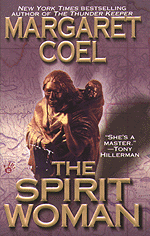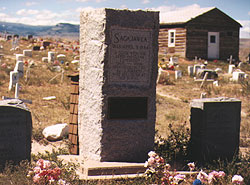


Winter's Child
Man Who Fell from Sky
Night of the White Buffalo
Killing Custer
Buffalo Bill's Dead Now
The Perfect Suspect
The Spider's Web
Silent Spirit
Blood Memory
Girl w/ Braided Hair
Drowning Man
Eye of the Wolf
Wife of Moon
Killing Raven
Shadow Dancer
Thunder Keeper
Spirit Woman
Lost Bird
Story Teller
Dream Stalker
Ghost Walker
Eagle Catcher







|
 |

 The Spirit Woman: An Interview with Margaret Coel
The Spirit Woman: An Interview with Margaret Coel
Your new novel brings in the story of Sacajawea, the Shoshone woman who went on the Lewis and Clark expedition in 1804-06. What made you
decide to write about Sacajawea?
I stood at the grave of a woman who had said she was Sacajawea. The grave is in a small cemetery outside Fort Washakie
on the Wind River Reservation. Over the grave is a large granite monument, very impressive. And like my character, Laura Simmons, I had the odd
sense that this was, indeed, the burial place of this remarkable Shoshone woman, despite the fact that the historians say Sacajawea is buried
somewhere in South Dakota. I was drawn to her, and I decided to bring her into the next novel.
Are you saying you didn't write the novel with the intention of publishing a story about Sacajawea the same year that the US Mint issued the
Sacajawea golden coin?
Exactly. I was well into writing the novel when I picked up the newspaper one morning and read about the coin. I could hardly believe it. Usually
the flow is going in the opposite direction to which I'm going.
How did you research the life of Sacajawea?
I began by reading just about everything that has been written on her, including published journals of Lewis and Clark. Along the way, I
accumulated a couple of shelves of books and stacks of magazine and journal articles that date back to the early 1900s.
 What do the records say about Sacajawea's fate?
What do the records say about Sacajawea's fate?
Written records indicate that Sacajawea and her husband, Toussaint Charbonneau, were at Fort Manuel Lisa in South Dakota in 1812. In
December of that year, the fort clerk wrote that the Shoshone wife of Charbonneau had died of putrid fever, and that she was the best woman in the
fort. This would seem to be pretty strong proof of Sacajawea's death, except for the fact that Charbonneau had at least two Shoshone wives, possibly
more.
But, there is other proof. In 1828, Captain William Clark himself listed the people who had gone on the expedition. Next to each name he wrote
down where the person was. After Sacajawea, he wrote, Dead.
Again, that would seem to be incontrovertible proof. However, Clark also wrote Dead next to the name of Patrick Gass, who would outlive the captain
by three decades.
What about the grave on the reservation?
The Shoshones and Arapahos believe that Sacajawea eventually returned to her people and went with them to the reservation in the 1870s. They
say she lived out her life there and died a very old woman, close to one hundred years, in 1884. This belief is based on oral history—stories handed
down about the old woman, who went by the name Porivo.
What do you think the truth is?
As a historian myself, I gravitate toward the written documents, as inconclusive and arguable as they may be. However, I find it very interesting
that the old woman on the reservation knew a great deal about the expedition. How could that be? She was illiterate. She couldn't have read the only
parts of the journal then published. (The Biddle edition, published in 1814.)
Yet she knew about the expedition and talked about many things that happened. Some historians have concluded she must have met the real
Sacajawea sometime before 1812 and heard her stories. I find that explanation more difficult to swallow than the possibility that she was the real
Sacajawea.
So what was your intent? To add to the controversy?
No. No. My only intent was to write the best mystery novel I could while bringing in a real mystery from history. And to take a look at the
different ways of accessing the past: the written records, which the western culture relies upon, and the oral records, which the Indian culture looks
to. Both are important. The truth of what happened to Sacajawea may someday be uncovered by a historian willing to examine both records
carefully.
 What other kind of research did you do?
What other kind of research did you do?
I had a wonderful time riding around on a Harley-Davidson motorcycle. Since one of the characters, Father John's new assistant, rides a Harley, I
decided I should try it. One of my cousins, Ron Dunning, rides a Harley. He propped me up on the back
and away we went, down the roads and byways of Colorado. I could become a biker!
|

|

